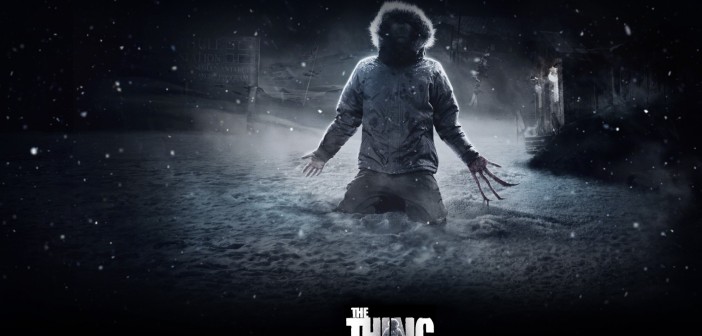This Thing Doesn’t Take Shape
Despite sharing the exact same title, The Thing is not a remake of John Carpenter’s 1982 film. Nor, for that matter, is it related to John Hawks’ 1951 film The Thing from Another World. It is, in fact, a prequel to Carpenter’s film, taking place three days earlier and telling the story of the ill-fated Norwegian science team stationed in Antarctica. Provided you’re familiar with this story, it doesn’t take a great leap of the imagination to figure out what happens. Carpenter’s film began with men in a helicopter shooting at an Alaskan malamute that actually wasn’t a malamute but a shape-shifting alien creature capable of absorbing and imitating other life forms; this new movie, on its most basic terms, is about how the creature came to be a dog. I admit that that sounds incredibly uninteresting, but there really is no other way to put it.
Adapted from the short story “Who Goes There?” by John W. Campbell, Jr., The Thing has plenty of gory monster effects for us to gawk at helplessly, especially now that computers have taken the place of practical makeup effects. It has its fair share of pop out scares, although a lot of the suspense is missing, in large part because there’s no real sense of mystery; there’s nothing about its nature or even its very existence that can surprise us, simply because Carpenter’s film already told us everything we needed to know. The only logical step would be to go back even further and examine how and why the creature left its home planet in the first place. But where’s the fun in that? Half of the reason these movies are so frightening is that we don’t know where it came from or why it ended up on Earth.
The story begins when an American paleontologist named Kate Lloyd (Mary Elizabeth Winstead) is recruited by a Norwegian scientist named Sandar Halversen (Ulrich Thomsen) to join his team in Antarctica, which found a crashed extraterrestrial spacecraft deep within a frozen cave. They also found a vaguely insectoid creature, seemingly dead, embedded in ice. Under the orders of Halversen, who is clearly driven more by conquest than by actual scientific research, the creature is extracted and taken back to the lab for testing. A drill is used to get a tissue sample from the huge block of ice, which drips away slowly, almost menacingly. It isn’t long before the creature dramatically breaks loose, bringing everyone into a state of panic. Sharp tendrils grab the first victim from underneath the camp, and we watch as this creature, whatever it is, begins the process of absorbing its prey before being torched alive with a gasoline can and a flare.
But that isn’t the end of it. Kate looks at a sample of the victim’s blood under the microscope; she not only finds cells belonging to both the victim and the creature, both still very much alive, she also finds that the creature’s cells can latch onto and transform themselves into the victim’s cells. It can mimic a life form at a cellular level. This means, then, that any or all of the people at the research station may not be what they seem. But how can Kate know for sure? Let’s just say that what they ultimately resort to is a woefully inferior variation of the tense blood testing scene in Carpenter’s film.
Many characters are introduced, but almost all of them are about as disposable as teenagers in a slasher film. Although this may appropriately play into the story’s inherent nihilism, it becomes problematic when the intention is to depict isolation and paranoia. Mental states, especially the more primal and terrifying ones, are only convincing if we’re actually made to care about the people involved. The one character with even a shred of personality is Kate, but even then, she’s little more than a pale imitation of Lt. Ellen Ripley of the Alien films. This becomes especially apparent when she arms herself with a flamethrower and, like the MacReady character in Carpenter’s film, spends a lot of her time torching the alien creature. The most prominent supporting player is Joel Edgerton as an American pilot named Carter, although he isn’t given all that much to do besides walk around with a wary look on his frost-covered face.
But what the movie lacks in character development it more than makes up for in style. With its bleak winter settings, its dark corners, and its disgustingly convincing special effects, it looks and sounds really good. My favorite shot is one in which the creature, having just revealed itself in terrifying fashion, scuttles up to an unlucky scientist and melds with him. One of the results is an elongated head, each half showing the face of a different person. Talk about a split personality. Many critics were unkind to Carpenter’s film upon its initial release, although it has since gained a following and has earned its place as a horror classic. It’s hard to know for sure, since cinematic tastes and attitudes consistently change, but I have a feeling 2011’s The Thing will not fare as well twenty to thirty years down the line.

